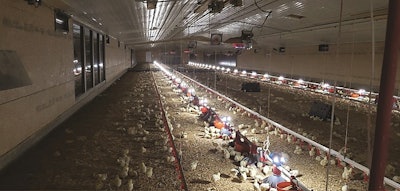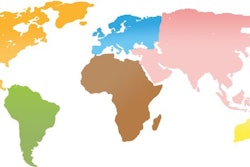
Focusing on the bird’s preferences and the animal welfare outcomes shapes continuous improvement at Tyson Foods Inc.
At the Georgia Precision Poultry Farming Conference presented by the University of Georgia’s Department of Poultry Science, Dr. Karen Christensen, senior director of animal wellbeing for Tyson, spoke about current animal welfare progress and plans at Tyson. She appeared on May 3, 2022.

Input- and output-based welfare
Animal welfare outcomes are, Christensen said, a measurable result or consequence of the process of raising, transporting and harvesting broiler birds. This contrasts with animal welfare inputs: changes in the growing system or environmental requirements not directly related to animal welfare outcomes. They are typically resource based and may or may not influence the outcomes.
For example, she called density requirements and breed requirements input-based animal welfare requirements.
The problem with input-based requirements, she said, is they neglect the importance of stockmanship. Input requirements are not an instant solution to welfare issues as they do not guarantee the birds will be well managed. Moreover, they send a false message to poultry producers and consumers that if they conform to input-based requirements then good welfare outcomes are guaranteed.
Input changes can negatively affect the environmental sustainability of commercial broiler production if they require the industry to build more houses and use more feed and water to produce the same amount of meat.
Instead, the broiler industry should focus on stockmanship. The results of that stockmanship should be measured on the key welfare indicators collected from the farm and the processing plant.
Continuous improvement
In the future, technology will greatly improve the industry’s ability to assess key welfare indicators like paw scores, hock burns and gait scores on the farm and transportation livability, broken wings, bruised legs and other processing outcomes at the processing plant.
Currently, the industry is sampling flocks by hand to gather this data. Its nearly impossible to collect these key welfare measurements on all the birds in a commercial setting. Once the technology is in the field, she said, the industry can collect and use all this powerful data to create measurable welfare improvements in real time.
If the entire industry embraced and focused on outcome-based welfare measurements rather than input-based welfare measurements, the overall welfare of broiler chickens would be significantly improved, she said. It also provides an opportunity to share data and evidence of improvements with customers and consumers and provide tangible proof of welfare improvements. It shows that the industry is doing a good job, is focused on welfare and the animals in its care have a good life.

Tyson’s research farm
Christensen said Tyson uses a broiler welfare research farm specially designed to simulate real settings in the field. At the time of her presentation, the farm had grown out 13 flocks.
The goal of this farm, she said, is to conduct animal welfare research on a commercial scale and immediately transfer advances to all houses in Tyson’s supply chain. The farm includes four houses built with viewing rooms. These rooms allow staff to observe the birds and their behaviors without interfering with the flock. It is also outfitted with various cameras to assist with camera-based research.
Preference research
Tyson also includes what she called preference research as a main component of its animal welfare strategy. This gives the birds a range of environmental choices and allows the birds to show what they want. Preference research is applied to enrichments, lighting and other features in the poultry house.
Ideologically, this allows the birds to dictate the conditions rather than humans assuming they inherently know better. Christensen said it allows people to see that broiler birds see the world differently than we do. There could be parts of their environment providing them stress and discomfort humans would never recognize.
Enrichments
Using preference research, Tyson performed trials using different enrichments to see which are most important for the birds and engaging to them.
The birds preferred what she called a hut, an enrichment allowing the animals to get underneath, or gather around the side of, it. She believes the birds preference for this engagement goes back to their status as a prey animal and genetic heritage in the jungle. Perhaps they like the enrichment because they want to hide and they feel safe from predators there.
Another successful enrichment is what she called a ramp, which allows the birds to climb up on top of it or hide underneath it. Few birds climb and perch on the enrichment but many huddle underneath the ramp.
Lighting
The same principals were applied to lighting the house. The bird views the world significantly different than a human and, again, wants to have a place to stay hidden. The research demonstrated the birds want a bright light over their feed and then a gradient of light as opposed to a consistent wall-to-wall light brightness.
Christensen said this behavior goes back to the jungle. They want to fill their crop quickly in a bright situation, like they might in the wild, then look for a dimmer place to rest and digest. They prefer medium lit areas to play or exhibit natural behaviors. This could be similar to the environment created by dense foliage and sparse rays of direct sunlight on the jungle floor.
The lighting research also showed birds want to rest away from food and water as well as in a dim area. This could be because the birds don’t want to fall asleep next to an area they perceive as risky for predation.
When a lighting system is altered to the point it provides the birds with a more complex, comfortable or interesting space. Tyson will focus on the role of lighting and bird behavior at the farm going forward.
Precision agriculture and technology
In the future, there are tremendous opportunities for rapidly advancing video- and audio-based technologies to advance animal welfare.
Tyson is involved with the Foundation for Food & Agriculture Research’s (FFAR) SMART project. This project is designed to accelerate the commercial deployment of promising welfare-related technologies.
The end goal of many of these projects is to convey the complex data collected by the devices in a simple way farmers can understand and use to solve problems in real time. When farmers can make adjustments quicker, or before an issue becomes harmful, then overall animal welfare improves.
The role of light, enrichments and technology in welfare WATTAgNet.com/articles/43675


















